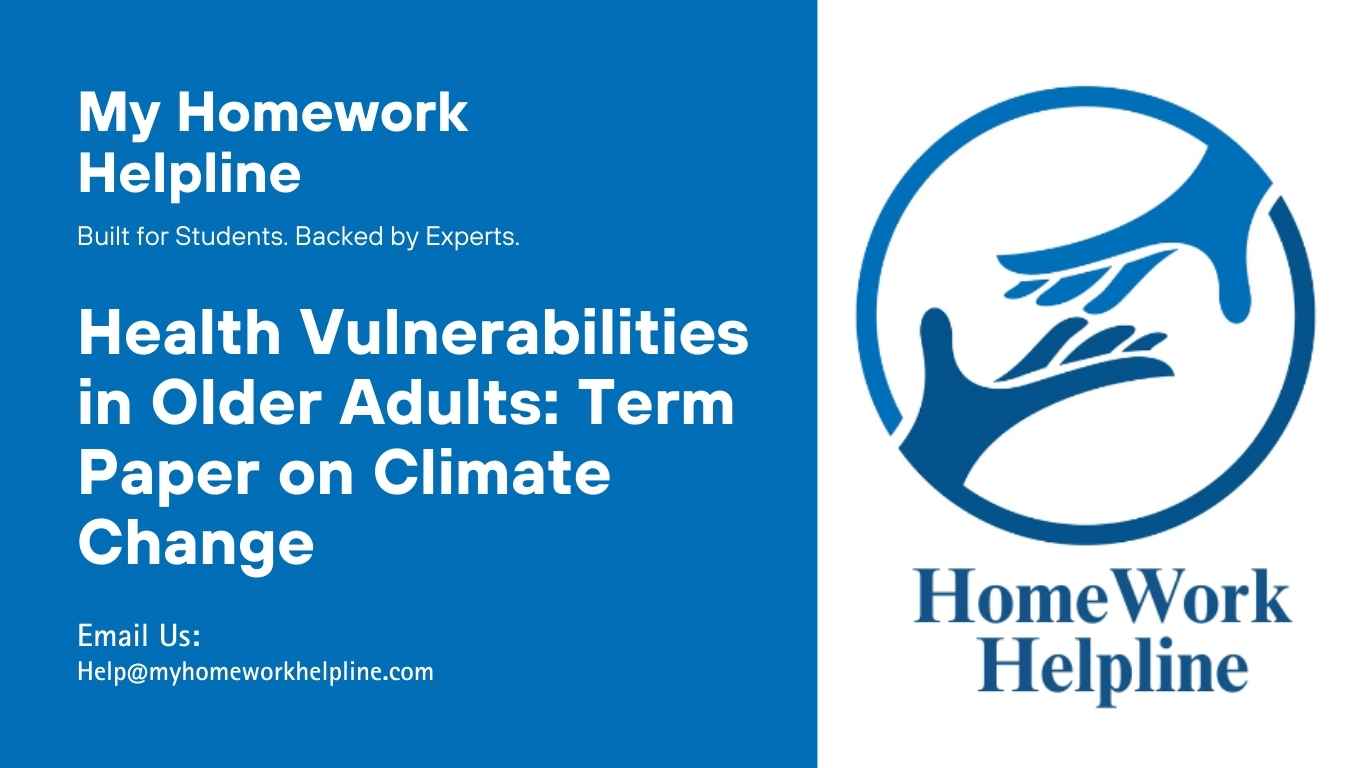Health Vulnerabilities in Older Adults: A Term Paper on Climate Change
According to WHO (2022), climate change is considered the biggest health threat to humankind. Currently, health professionals globally have started responding to health problems caused by the climate change. Thomas et al. (2019) states that climate change tends to affect both environmental and social determinants of health, including safe drinking water, clean air, secure shelter, and sufficient food.
Climate Change Impact on Older Adults
Impact of climate change on health harms for older people tend to be more serious and complex, making older people more vulnerable to this crisis. Humans become more vulnerable to environmental effects, including air pollution as they age. The old group of a population are more likely to acquire health conditions that make them more sensitive to climate hazards such as air pollution and heat, which tend to worsen their existing illnesses. Experts have estimated that climate change will result in an additional 250,000 deaths every year, resulting from malaria, malnutrition, heat stress, and diarrhea between 2030 and 2050. A report by WHO stated that nearly 75 million adults in America aged 60 years and above make up one-fifth of the population. Research over time has shown that older adults are more vulnerable due to limited mobility.
Vulnerability as a multidimensional process is impacted by economic, social, and political forces interacting from international as well as local scales. Older people are more likely to be affected by adverse weather conditions such as drought, floods, and fires. Research also shows aging and certain medications can impact one’s body’s ability to respond to climate change. This tends to put older adults aged fifty and above at a high risk of illness and death as the climate warms. The fact that old people lack strong immune when compared to young people makes the old adults more prone to severe illness from insect- and water-related diseases associated most commonly with the warming climate. In addition, old people may be dependent on others for medical care and assistance with daily life, hence increasing their vulnerability to climate change.
Need professional support with sociology assignments or term papers on topics like health vulnerabilities in older adults? Our team at Sociology Homework Helpline provides expert guidance on research papers, essay writing, and critical analysis of complex social and environmental issues. Whether it’s coursework, term papers, or full academic assignments, we deliver plagiarism-free, timely, and expertly crafted homework assistance to help you achieve top grades and deepen your understanding of social determinants and public health.
Vulnerability and Social Factors
Vulnerability is associated with reduced exposure, adaptive capacity, and sensitivity. Climate change is a phenomenon that is affecting an already-complex social landscape since individuals have different access to resources. In this regard, it is true to argue climate change as drought has led to reduce access of resources such as water, that is crucial for healthy living. Apart from reduction in resources access due to climate change, the old adults are faced with challenge of scarce resources such as food stores, insurance, alternative housing, emergency response, disaster warning system, liquid assets, private capital, transportation, durable infrastructure, migration support, information, and communication network, and transportation. Based on this scarcity of resources for the old Adults, the potential health risks for older adults include injuries or death, water-related illnesses, mental health effects, insect and tick-related diseases, heat illnesses, and respiratory illnesses.
The poor also tend to be vulnerable to impact of climate change on their health as vulnerability is determined by the institutional, economic, and political capacity of different individuals affected by climate-related events. A report from a study conducted by Healthdata.gov. (2022) showed that people earning less than $12,800 or with a household income below $26,500 were found to be particularly malnourished. In addition, poverty rate in the US has been on the rise for the last five years. For instance, the poverty rate increased by 11.4%, which is a total of 37.2 million people in 2020 (Healthdata, 2022). As a result, the potential health risks for the poor and older adults include injuries or death, water-related illnesses, mental health effects, insect- and tick-related diseases, heat illnesses, and respiratory illnesses.
Vulnerability is also impacted based on power differentials. Power differentials can be described as the ability to coerce or influence different groups. Social powers arise from social hierarchies responsible for creating inequalities in resource access, endangering differential vulnerable populations, especially older adults. The vulnerability occurs particularly through processes that perpetuate or expand poverty and marginalization, and in some cases, including planning. As a result, the potential health risks for older adults include injuries or death, water-related illnesses, mental health effects, insect- and tick-related diseases, heat illnesses, and respiratory illnesses.
Social determinant of health theory supports the vulnerability discussed in this paper as the theory claims that wider social contexts result in a social grouping that affects vulnerability and exposure to risk by given groups.
Solutions
Some of the solutions that will help address the problem of climate change in terms of vulnerability may be countered via transmission of environmental knowledge, making healthy food and energy accessible, and reduction in emission of green-house gasses to the atmosphere. Previous studies have shown that adults are dying in their fifties even with improved health choices such as regular excesses and abstaining from smoking. Therefore, we need to develop a better system to reduce the production of greenhouse gases. This will reduce the warming of the atmosphere and the production of other toxic gases, leading to increased health issues for older adults.
Regarding CO2 emissions and climate change, the world has witnessed a 30% increase in atmospheric anthropogenic CO2 concentrations from pre-industrial (before 1750) levels of 280 ppm to 400 ppm presently. Today’s CO2 levels in the atmosphere are estimated to be the highest levels over the past 650,000 years, as from data extracted from ice cores (Sarwar et al., 2022). CO2 is the most significant greenhouse gas, contributing 72% to overall climate change. In the wake of global warming, rising energy demands, and inefficiency of current energy systems, the global challenge of significantly abating CO2 emissions has made it imperative to reduce dependence on fossil fuels while still catering to our energy needs (Sarwar et al., 2022). Some of the solutions to help address pollution via CO2 emissions consist of improved energy transformation efficiency, improved end-use energy efficiency, expanded use of alternative energy sources, improved use of nuclear power, behavioral and lifestyle improvements to decrease demand, and Carbon Capture, Utilization, and Storage (CCUS) (Sarwar et al., 2022).
Conclusion
It is clear climate change is the biggest health threat to humankind. Climate change currently being experienced have an impact on the health of humans, especially old Adults due to weak Immune system based on aging. The old adults tend to be more impacted by severe climate change events such as droughts and floods. In addition, the vulnerability of young adults is also impacted by social factors such as poverty, access to resources, and power differentials. Some of the solutions that may help reduce the impact of climate change on the health of people such as old Adults include promoting healthy eating and lifestyle in the communities and schools as well as reducing the emission of CO2 to the atmosphere leading to global warming being experienced today. Carbon can also be captured and stored for later utilization in industries such as those involved in producing soft drinks like Soda.
References
Epa. (2022). epa.gov (2022) U.S. Environmental Protection Agency. EPA https://www.epa.gov/
Healthdata (2022) Social Determinants and Health Equity Resource Guide https://healthdata.gov/dataset/Social-Determinants-and-Health-Equity-Resource-Gui/vbjv-rh5z
Sarwar, S., Waheed, R., Farooq, M. U., & Sarwar, S. (2022). Investigate solutions to mitigate CO2 emissions: the case of China. Journal of Environmental Planning and Management, 65(11), 2054-2080.
Thomas, K., Hardy, R. D., Lazrus, H., Mendez, M., Orlove, B., Rivera‐Collazo, I., … & Winthrop, R. (2019). Explaining differential vulnerability to climate change: A social science review. Wiley Interdisciplinary Reviews: Climate Change, 10(2), e565.
WHO (2022) Publications. https://www.who.int/data/gho/publications

